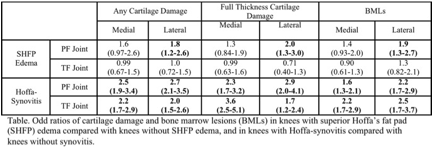Session Information
Session Type: ACR Poster Session C
Session Time: 9:00AM-11:00AM
Background/Purpose: To determine the relation of superolateral HoffaÕs fat pad (SHFP) edema and Hoffa-synovitis to cartilage damage and bone marrow lesions (BMLs) in the patellofemoral (PF) and tibiofemoral (TF) joints.
Methods: The Multicenter Osteoarthritis (MOST) study is a NIH-funded longitudinal cohort study of older individuals with or at risk for knee OA. We used data from the 60-month study visit where all eligible subjects had knee MRI assessed for other structural features of knee OA. SHFP edema and Hoffa-synovitis (infrapatellar and/or intercondylar) were assessed on sagittal proton density-weighted fat-suppressed MRI images by two musculoskeletal radiologists and dichotomized into presence (>1) and absence (=0). Cartilage damage and BMLs were scored in the PF and TF joints. We used three definitions of structural damage: 1) any cartilage damage (WORMS score of ³2), 2) full-thickness cartilage damage (WORMS score 2.5, 5-6) and 3) any BML (WORMS score of ³1). We further defined the location of PF and TF joint damage in the lateral and medial compartments. Separate logistic regression models were used to determine the relation of SHFP edema to our three definitions of structural damage in the medial and lateral PF and TF joints, adjusting for age, sex and BMI. The same models were used with HoffaÕs synovitis as the exposure instead of SHFP edema.
Results: 1041 knees were included; Mean (sd) age and BMI were 66.8 (7.5) and 29.6 (4.8), respectively; 65% were female. SHFP edema and Hoffa-synovitis was present in 12.7% and 59.3% of knees, respectively. Compared with knees without SHFP edema, knees with SHFP edema showed statistically significant increase in odds of any and full-thickness cartilage damage, and any BML in the lateral PF joint only. Compared with knees without synovitis, knees with Hoffa-synovitis showed statistically significant odds of any and full thickness damage, and BMLs in all 4 compartments (table).
Conclusion: While synovitis is a marker of whole-joint disease, SHFP edema is a surrogate of local lateral PF joint disease only. SHFP edema is likely the result of mechanical impingement and maltracking leading to local structural abnormalities like cartilage and osseous changes. 
To cite this abstract in AMA style:
Jarraya M, Guermazi A, Felson DT, Roemer F, Nevitt MC, Torner J, Lewis CE, Stefanik J. The Association of Superolateral Hoffa’s Fat Pad Edema and Synovitis with Structural Changes in the Patellofemoral and Tibiofemoral Joints: The Multicenter Osteoarthritis Study [abstract]. Arthritis Rheumatol. 2016; 68 (suppl 10). https://acrabstracts.org/abstract/the-association-of-superolateral-hoffas-fat-pad-edema-and-synovitis-with-structural-changes-in-the-patellofemoral-and-tibiofemoral-joints-the-multicenter-osteoarthritis-study/. Accessed .« Back to 2016 ACR/ARHP Annual Meeting
ACR Meeting Abstracts - https://acrabstracts.org/abstract/the-association-of-superolateral-hoffas-fat-pad-edema-and-synovitis-with-structural-changes-in-the-patellofemoral-and-tibiofemoral-joints-the-multicenter-osteoarthritis-study/
